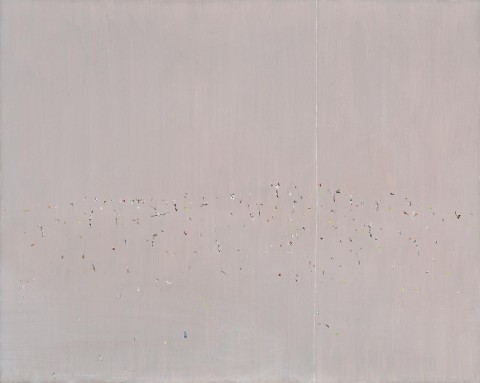AUSTRALIAN LANDSCAPE, 1969
FRED WILLIAMS
oil on canvas
122.0 x 152.5 cm
signed lower left: Fred Williams
signed on stretcher verso: Fred Williams.
Private collection, Melbourne, acquired directly from the artist, June 1980
Sotheby’s, Melbourne, 22 April 1996, lot 59
Private collection, Sydney
Blue Chip XIII: The Collectors’ Exhibition, Niagara Galleries, Melbourne, 8 March – 2 April 2011, cat. 5 (stock no. 13910V, label attached verso)
My Favourite Things, Liverpool St Gallery, Sydney, June 2018
We are grateful to Lyn Williams for her assistance with this catalogue entry.
'What a magnificent painter Fred Williams is! There is every chance he will go down in history as Australia’s greatest landscape artist … Williams clarifies our vision, develops our understanding, defines our land.'1
Written less than a decade after Fred Williams decided to focus on the landscape as the primary subject of his art, these prophetic words accurately anticipated the contribution he would make to the tradition of landscape painting in Australia. Williams’ unique vision of the natural environment – from scrubby bush on the edges of suburbia, to pristine coastal views and the vast dry inland country – captured its essence, creating archetypal images that have since become part of our collective visual memory and in turn, shape the way we view our country.
During the late 1960s Williams produced a strikingly minimal series of paintings which he titled simply the Australian Landscapes. His deep engagement with the landscape and close observation of its diversity – from the saplings of Sherbrooke Forest, to the country around Lysterfield and the nearby Upwey regenerating after bushfires, and the rocky granite hills of the You Yangs – had prompted Williams to consider the continuity that existed beneath the ‘skin’ of the land, despite the obvious visible variations. Following a visit to the outback in 1967 he wrote in his diary, ‘The trip has been fascinating – it rather convinces me that there is something very similar running through the Aust[ralian] Landscape (any landscape) so much so that I may drop the regional titles from all paintings’.2
Masterful works followed, including Landscape ’69 triptych, 1969 – 70 (National Gallery of Australia, Canberra), where a few deftly painted trees and fallen branches dance lightly across a grey ground, as Williams pared back pictorial and painterly detail. Patrick McCaughey has noted that until 1968 Williams was intent on developing his own visual language, but with strong foundations of formal invention and solid craftsmanship, as well as professional acknowledgement and some commercial success, by this time he had the confidence to experiment and absorb elements of contemporary painting into his own practice.3 The influence of Minimalism and late 1960s abstraction, styles of art that focussed on the conceptual and aesthetic rather than recognisable subject matter, is clearly evident in the paintings of these years. As the current Australian Landscape, 1969 shows, the works that came next were even more refined – open fields of virtually unmodulated colour (typically cool greys or various shades of ochre), sometimes divided, as we see here, by one or two fine vertical lines of exposed canvas, with a series of delicately painted marks like personal hieroglyphics, which suggest various landscape forms. Serenely minimal from a distance, this work defies such easy categorisation upon close inspection as colour shimmers across the surface, finely variegated brushstrokes defining the gentle outline of a hill and creating a sense of three-dimensional space. While Williams removed many of the traditional elements of the genre from his Australian Landscape images, they nevertheless retain a strong feeling of their subject, so much so that the experience of being in the landscape often mirrors that of viewing his paintings: ‘in the bush, where the peering eyes move from the veins of a leaf to the colour of a pebble, to the curl of a fern, to the discreet glint of a modest flower – so in Williams’ paintings does the eye probe among the touches and discover its lode of visual treasures’.4
1. Thornton, W., quoted in Grant, K., & Phipps, J., Fred Williams: The Pilbara Series, exhibition catalogue, National Gallery of Victoria, Melbourne, 2002, p. 17
2. Williams, F., diary entry, 9 November 1967, quoted in Hart, D., Fred Williams: Infinite Horizons, exhibition catalogue, National Gallery of Australia, Canberra, 2011, p. 101
3. McCaughey, P., Fred Williams 1927-1982, Murdoch Books, Sydney, 1996, pp. 210 & 217
4. Gleeson, J., quoted in Mollison, J., A Singular Vision: The Art of Fred Williams, Australian National Gallery & Oxford University Press, Canberra, 1989, p. 141
KIRSTY GRANT
